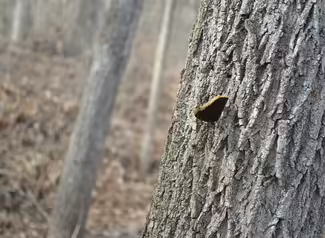
A winter butterfly sighting
We have had some warm weather this February, which means it is time to keep an eye out for butterflies! You may be thinking I am in the wrong hemisphere, but there is a chance you can spot butterflies on a warm winter day in Illinois, namely the mourning cloak butterfly.
Despite its drab name, the mourning cloak butterfly might be one of spring’s earliest flowers. I first learned of this butterfly in 2015 as my sons and I took a walk on a warm winter day and we encountered an unexpected sight, a butterfly! It was resting upside-down sipping away at tree sap along with a flurry of ants. As the butterfly fed, the warm late-winter sun warmed its wings.
With its wings folded the mourning cloak appears relatively unremarkable. The outside of its wings is dark, resembling charred wood. As we watched the butterfly’s wings spread open my oldest son exclaimed “It’s a butterfly!” The dark inner portion of the wings contrasts nicely with a pale yellow band along the wing edge. A band of blue dots adds a distinct flair to the butterfly’s markings. After snapping several pictures we returned home to learn more about our little friend.
Lifecycle of mourning cloak butterfly
Mourning Cloak (Nymphalis antiopa) is one of the first butterflies to make an appearance in spring. It overwinters as an adult under bark or within tree crevices. The adults mate in spring and females lay their eggs on the twigs of host plants. Caterpillars hatch in late spring to early summer, collectively feeding on the newer leaves of host plants. Host plants for the mourning cloak caterpillar include:
- Black willow (Salix nigra)
- Weeping willow (S. babylonica)
- Silky willow (S. sericea)
- American elm (Ulmus americana)
- Cottonwood (Populus deltoides)
- Aspen (P. tremuloides)
- Paper birch (Betula papyrifera)
- Hackberry (Celtis occidentalis)
Like the adult butterfly, the caterpillar is quite striking. It grows up to two inches long and has a black body, stippled in white dots, and then larger red dots along its back. Tall black spines decorate the caterpillar giving it a menacing look.
Mourning cloak caterpillars pupate in a chrysalis shaped like a dead, curled leaf, but with spines that would make you think twice about touching it. Once it finishes the amazing process of metamorphosis, the adult butterfly emerges in June-July. After feeding briefly as adults, the mourning cloak butterfly estivates (similar to hibernation but in summer) until fall. Feeding resumes in autumn as the butterfly stores energy in preparation for winter hibernation. You may find mourning cloak butterfly nectaring on flowers, but its preferred diet as an adult is tree sap and rotting fruit. With a 10- to 11-month adult lifespan, the mourning cloak butterfly may be the longest-lived butterfly.
Mourning cloak butterflies have a massive range and are found throughout North America, south of the Canadian tundra, north of Central Mexico, and even into temperate Eurasia.
So, keep an eye out during these warm winter and early spring days. You may encounter a mourning cloak butterfly, the first butterfly of the year.
Good Growing Fact of the Week: The caterpillar of the mourning cloak butterfly is named the spiny elm caterpillar. Though they feed in groups, they often do not cause any lasting harm to their host trees and control is not necessary.
Sign up for our emails! Want to get notified when new Good Growing posts are available? SIGN ME UP
MEET THE AUTHOR
Chris Enroth is a horticulture educator with University of Illinois Extension, serving Henderson, McDonough, Knox, and Warren counties since 2012. Chris provides horticulture programming with an emphasis on the home gardener, landscape maintenance personnel, and commercial landscapers. Additional responsibilities include coordinating local county Master Gardener and Master Naturalist volunteers - providing their training, continuing education, advanced training, seasonal events, and organizing community outreach programs for horticulture and conservation assistance/education. In his spare time, Chris enjoys the outdoors, lounging in the garden among the flowers (weeds to most).

